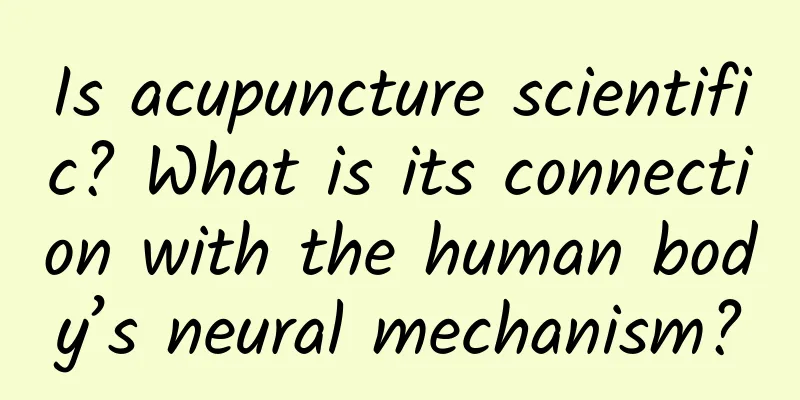Is acupuncture scientific? What is its connection with the human body’s neural mechanism?

|
Have you ever had acupuncture? People who have never had it feel painful just thinking about it, but people who have had it say it is magical. Why does acupuncture have anti-inflammatory and analgesic effects? What is the scientific basis behind this? Hello everyone, I am Xiao Wei who studies science in depth. Today we are going to talk about what acupuncture is and how it relates to the human nervous system. Many people have heard of acupuncture, but not all have tried it. It is a very important part of traditional Chinese medicine and has a long history. The earliest acupuncture therapy can be traced back to the Neolithic Age, about 7,000 to 8,000 to 4,000 years ago. The original acupuncture needles were made of stone, called "Bian stone". Acupuncture therapy first appeared in the Yellow Emperor's Classic of Internal Medicine around 100 BC. Doctors at that time found that acupuncture was useful in treating diseases, so they began to gradually use and promote it. During the long process of development, many traditional medical works emerged. According to the development history of acupuncture, we can divide it into the Wei, Jin, Sui and Tang Dynasties, the Song, Jin and Yuan Dynasties, the Ming and Qing Dynasties, the Republic of China Period and the New China. Among them, Yang Jizuo, a scholar in the Ming Dynasty, conducted extensive collection and compilation of acupuncture documents of his predecessors and compiled many works of acupuncture documents from past dynasties. This is the "Compendium of Acupuncture and Moxibustion", which forms the basis of modern acupuncture. Although acupuncture can be regarded as a gem in traditional Chinese medicine, the scientific nature of this therapy has always been controversial. Even many Chinese scholars do not believe in it, let alone its application in the international medical field. However, with the development of modern medicine, scientists have gradually become more interested in acupuncture. As early as the 1970s, scientists discovered that acupuncture points have a certain scientific basis. In 1979, researchers stimulated various skin areas in rats and found that it affected the rats' nerve reflexes and gastric motility. In 2014, another group of scientists found that stimulating acupuncture points in mice had physiological effects. They used electroacupuncture to stimulate a specific acupuncture point, ST36, on the mice's bodies, and found that it activated the mice's vagus nerve system and relieved inflammation. Please note that the specific site we mentioned here is actually the "Zusanli" acupoint in traditional Chinese medicine. Since then, another team, led by neuroscientist Ma Qiufu, who has just joined Westlake University, has also conducted in-depth research. In 2020, they found that stimulating the ST25 and ST36 acupoints of mice can respond to inflammation. These two acupoints correspond to the "Tianshu" and "Zusanli" acupoints in traditional medicine. So far, scientists have proved to some extent that acupoints exist. So why can stimulating acupoints induce physiological changes? What is the principle behind this? In order to explore the mechanism behind acupuncture, the researchers fluorescently marked the sensory neurons on the back of mice, and then performed acupuncture and neuron knockout operations. They found that the effect of acupuncture was related to the activation of sensory neurons in this area, which in turn activated the vagus nerve-adrenal anti-inflammatory pathway, thereby achieving the purpose of treating the disease. What’s amazing is that the researchers can also predict the anti-inflammatory effect of acupuncture at different acupoints in mice based on the distribution of this type of nerves. Scientists not only figured out the neurological mechanism behind acupuncture, but also published a paper in the top journal Nature. Of course, after the publication of this study, the public was talking about it. It is worth mentioning that there are some differences between traditional acupuncture and acupuncture. Acupuncture is a general term for acupuncture therapy and moxibustion therapy. Acupuncture has many quantitative indicators, but the results of this study have opened a door for acupuncture to move from traditional medicine to modern medicine. Just when the Chinese scientific research community was skeptical about the efficacy of acupuncture, the United States also noticed this track and began to make efforts secretly. In October 2016, the National Institutes of Health launched a research program called stimulating peripheral activity to relieve condition (SPARC). The name of this project may seem complicated, but the core is actually very clear - to study whether nerve stimulation can reduce inflammation. This is almost consistent with the neuroanatomical mechanism related to acupuncture points that we just talked about. After learning about this plan, Chinese scientists slapped their thighs and thought, isn't this acupuncture? Why did our traditional medicine still get ahead of the United States? While regretting, they also reflected. The "take-it-as-it-is" approach of Western medicine in this SPARC plan has both "inheritance" and innovation, which is worth deep thought for Chinese acupuncture researchers. It is based on traditional Chinese medicine and is an innovative systematic study based on Western medical logical thinking and medical practice. It can be seen that the modernization of traditional Chinese medicine is very important, and only in this way can it go international. Back to acupuncture. How to systematically explore the intrinsic connection between acupuncture, acupoints and the nervous system, and clarify the neuroanatomical mechanism behind acupuncture, may be the only way for acupuncture to be "modernized". We also hope that acupuncture treatment will become more and more scientific in the future and play a greater role on the international medical stage. This article is a work supported by Science Popularization China Starry Sky Project Team Name: Deep Science Reviewer: Qin Lina Produced by: China Association for Science and Technology Department of Science Popularization Producer: China Science and Technology Press Co., Ltd., Beijing Zhongke Xinghe Culture Media Co., Ltd. |
<<: Spring Health Post丨Does pollen allergy mean reduced immunity? How to distinguish it from a cold?
Recommend
What does a tree sparrow look like?
When it comes to wild birds, sparrows are probabl...
"Naruto" ends: Is the domestic Naruto industry chain also over?
Have you ever watched "Naruto"? This co...
Taichi iOS 8.4 for Mac is now jailbroken
Taiji jailbreak team finally released the iOS 8.4...
Case analysis: How to use Internet thinking for online promotion?
With the high penetration of the Internet, the le...
Wanmen University "Love Psychology" course
Introduction to the training course content: As an...
The "Exploration No. 1", which once caught lionfish and hook shrimp in the deep sea of 10,000 meters, has completed a new mission
On the afternoon of January 26, the "Explora...
WeChat: The mini-program jump to APP function has been abused and will no longer be supported
On May 14, WeChat issued a notice that "WeCh...
Who will protect the security of facial recognition?
The first public crusade against facial recogniti...
SMIC: 2Q20 revenue of US$938.5 million and net profit of US$138 million
On August 6, 2020, SMIC announced its second quar...
[Popular Science of Chinese Military Technology] How does armor perspective technology allow tank soldiers to use "hacks"?
With the progress of the times, the wide area and...
Which Olympic Games is the 2022 Beijing Winter Paralympics? Attached is the start and end times of the 2022 Beijing Paralympic Winter Games!
After Beijing's successful bid, it became the...
How can APP achieve fission-like dissemination and capture the user's psychology?
The most important thing about fission-style comm...
"Nezha 2" tops the list! What are the differences between IMAX, 2D, and 3D movie viewing?
Review expert: Zhou Yu, professor and vice dean o...
Can myopia be reduced from 800 degrees to 100 degrees? The truth is different from what you think
Author: Jin Xin, Director of the Shouyang Myopia,...
How to build your first machine learning model on your iPhone
introduction As a data scientist, I have always h...









